Hip Hop serves as a powerful voice for marginalised communities, addressing social justice and identity issues. This article explores its roots in the Bronx, the significance of social commentary, and the diverse regional variations that shape its sound. Additionally, it examines the impact of technology and collaboration within the genre, highlighting how Hip Hop continues to influence youth culture today.
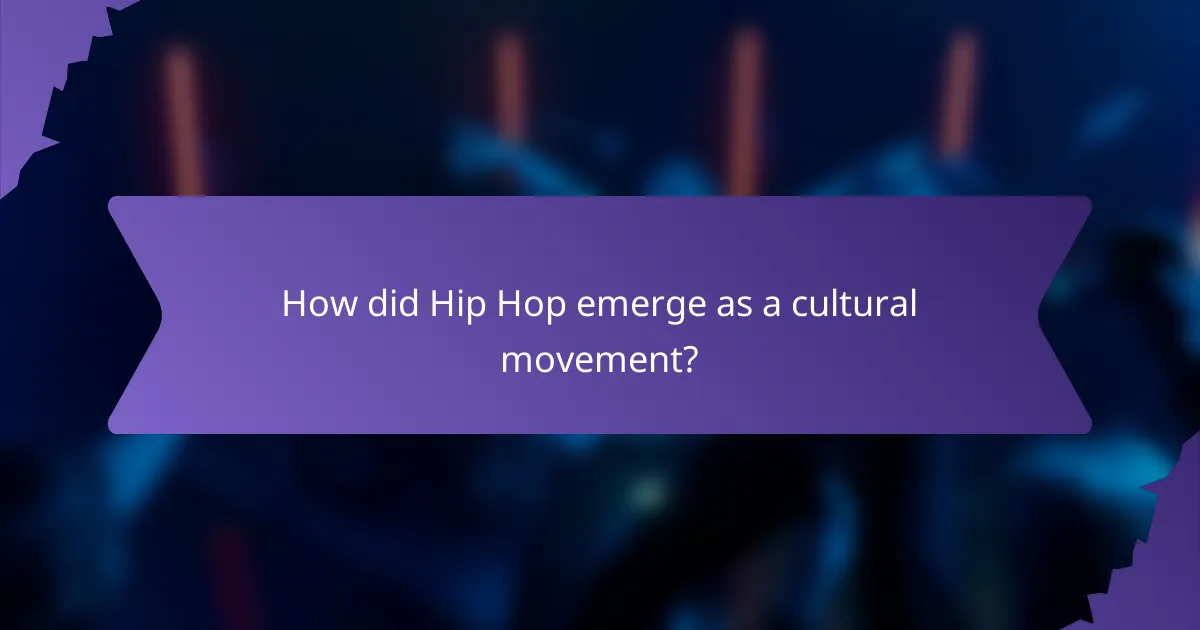
How did Hip Hop emerge as a cultural movement?
Hip Hop emerged as a cultural movement in the 1970s, rooted in African American and Latino communities in the Bronx. It served as a powerful form of social commentary, addressing issues like poverty, racism, and violence. The genre evolved through various styles, including rap, DJing, and breakdancing, each reflecting the unique experiences of its creators. Hip Hop’s influence has grown globally, shaping music, fashion, and art, while maintaining its core message of resilience and empowerment.
What key historical events influenced Hip Hop’s development?
Key historical events that influenced Hip Hop’s development include the civil rights movement, urbanisation, and the rise of disco. The civil rights movement shaped the social commentary aspect of Hip Hop, highlighting racial injustices. Urbanisation in the 1970s led to the emergence of block parties in New York City, fostering community and creativity. The rise of disco provided a musical backdrop, influencing Hip Hop’s beats and rhythms. Each of these events contributed to the genre’s evolution, underscoring its roots in social awareness and cultural expression.
Which artists were pivotal in shaping the early Hip Hop scene?
Artists such as DJ Kool Herc, Afrika Bambaataa, and Grandmaster Flash were pivotal in shaping the early Hip Hop scene. DJ Kool Herc is known for his innovative breakbeat DJing techniques, which laid the foundation for Hip Hop music. Afrika Bambaataa introduced the concept of Hip Hop as a cultural movement, emphasising unity and social change. Grandmaster Flash advanced DJing skills and was crucial in developing the art of turntablism. Their contributions formed the roots of Hip Hop, influencing its evolution and social commentary.
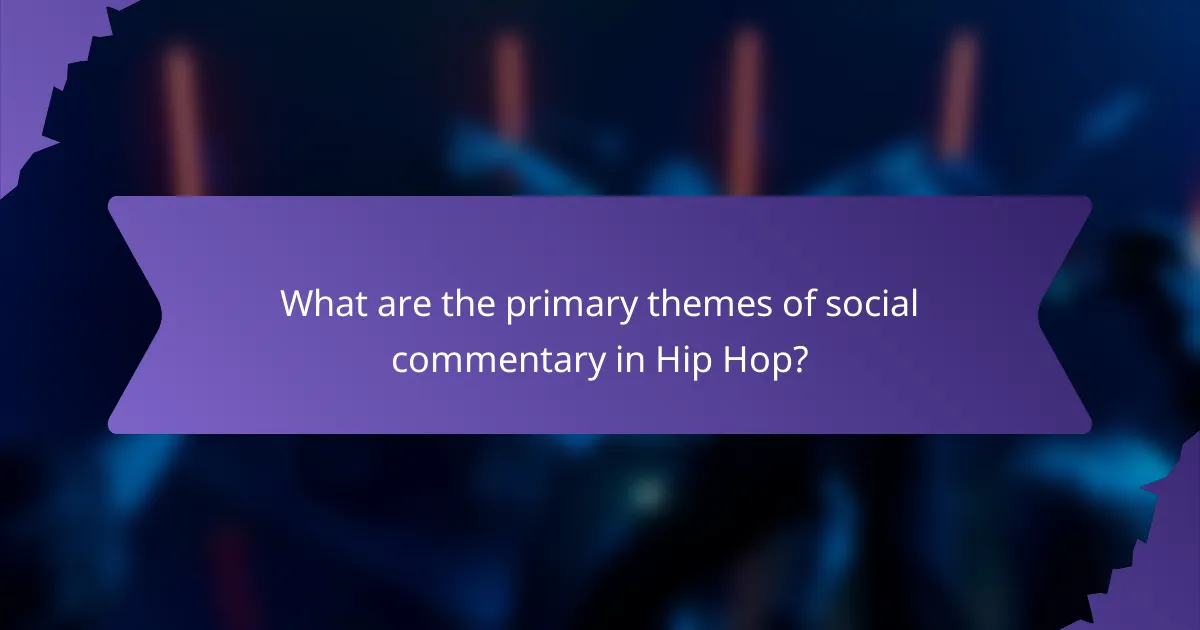
What are the primary themes of social commentary in Hip Hop?
Hip Hop primarily addresses themes of social justice, inequality, identity, and resistance. These themes reflect the struggles and experiences of marginalised communities, often highlighting systemic issues such as racism, poverty, and police brutality. Artists use their platform to provoke thought and inspire change, making social commentary a vital aspect of the genre. The unique attribute of Hip Hop lies in its ability to blend personal narrative with broader societal critiques, creating a powerful form of expression that resonates across diverse audiences.
How does Hip Hop address issues of race and identity?
Hip Hop addresses issues of race and identity by expressing personal and collective experiences. The genre serves as a platform for marginalised voices, highlighting systemic inequalities and cultural pride. Artists like Kendrick Lamar and Nas often tackle racial injustices, using storytelling to connect with listeners. This social commentary fosters awareness and encourages dialogue about identity and social issues. Through its roots in African American culture, Hip Hop uniquely reflects the complexities of race, identity, and resilience.
In what ways does Hip Hop critique socio-economic conditions?
Hip Hop critiques socio-economic conditions by addressing systemic inequality, poverty, and racial injustice. Artists use their platforms to highlight struggles faced by marginalised communities. Through storytelling, they reflect on personal experiences and societal issues, fostering awareness and dialogue. For example, tracks often discuss police brutality, housing instability, and lack of access to education. This genre serves as a voice for the voiceless, empowering listeners to confront and challenge oppressive systems.
Which contemporary issues are reflected in modern Hip Hop lyrics?
Modern Hip Hop lyrics reflect contemporary issues such as social injustice, racial inequality, and mental health struggles. Artists use their platform to address systemic oppression and personal experiences, creating powerful social commentary.
Key themes include police brutality, economic disparity, and the impact of technology on society. For example, songs often critique government policies and advocate for change. The genre’s evolution showcases diverse voices, emphasising the importance of authenticity and storytelling in addressing these pressing issues.
Hip Hop serves as a cultural barometer, capturing the zeitgeist and resonating with listeners who relate to these challenges. The genre’s unique ability to blend personal narrative with broader societal critiques makes it a vital form of modern expression.
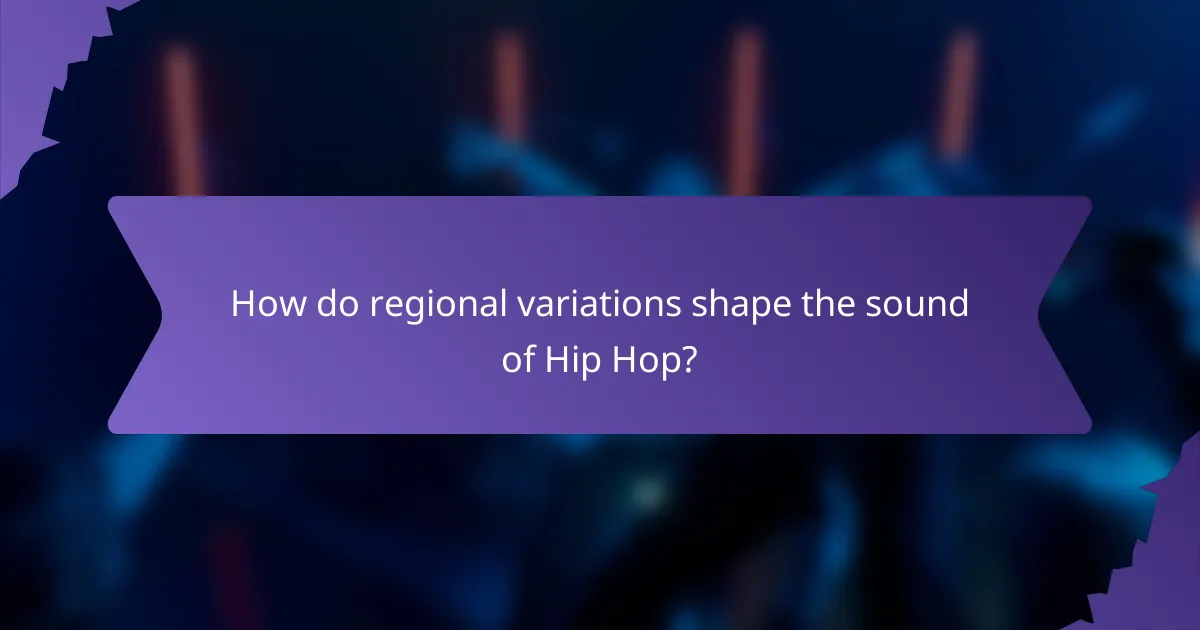
How do regional variations shape the sound of Hip Hop?
Regional variations significantly influence the sound of Hip Hop through diverse cultural expressions and local dialects. Each region develops unique styles, rhythms, and lyrical themes that reflect its social environment. For instance, East Coast Hip Hop often features complex lyricism and jazz influences, while West Coast sounds emphasise laid-back beats and funk elements. Southern Hip Hop incorporates trap beats and distinctive vocal delivery, showcasing a unique cultural blend. These variations not only shape the genre’s musical landscape but also serve as a form of social commentary, resonating with local audiences and experiences.
What distinguishes East Coast Hip Hop from West Coast Hip Hop?
East Coast Hip Hop is characterised by its lyrical complexity and emphasis on social issues, while West Coast Hip Hop focuses on laid-back beats and party themes. East Coast artists often incorporate intricate wordplay and storytelling, reflecting urban struggles. In contrast, West Coast artists tend to emphasise a more relaxed lifestyle, often celebrating California culture and experiences. Notable East Coast figures include Nas and Jay-Z, known for their intricate narratives. Conversely, Dr. Dre and Snoop Dogg represent the West Coast, showcasing a distinctive sound that has influenced mainstream music.
Which unique styles have emerged from Southern Hip Hop?
Southern Hip Hop has birthed unique styles like Crunk, Trap, and Bounce. These genres reflect regional influences and cultural narratives.
Crunk originated in Memphis, characterised by high-energy beats and call-and-response vocals. Trap emerged from Atlanta, known for its use of hi-hats and heavy bass, focusing on street life themes. Bounce, from New Orleans, features upbeat rhythms and distinct call-and-response patterns, often incorporating elements of local culture.
These styles showcase the diversity within Southern Hip Hop, each contributing to the genre’s evolution and social commentary.
How does UK Grime differ from traditional Hip Hop?
UK Grime differs from traditional Hip Hop primarily in its sound, cultural context, and lyrical style. Grime incorporates faster beats, often around 140 BPM, and features a distinct UK accent. Traditional Hip Hop focuses on slower beats and often emphasises storytelling and social commentary.
Grime emerged in the early 2000s from UK garage and has a raw, energetic feel. It reflects urban life in the UK, addressing local issues and experiences. Traditional Hip Hop, rooted in the Bronx, often tackles broader themes like social justice and identity.
Lyrically, Grime uses a more aggressive and rapid-fire delivery compared to the rhythmic flow of traditional Hip Hop. This unique attribute of Grime sets it apart, creating a distinct cultural identity within the hip hop genre.
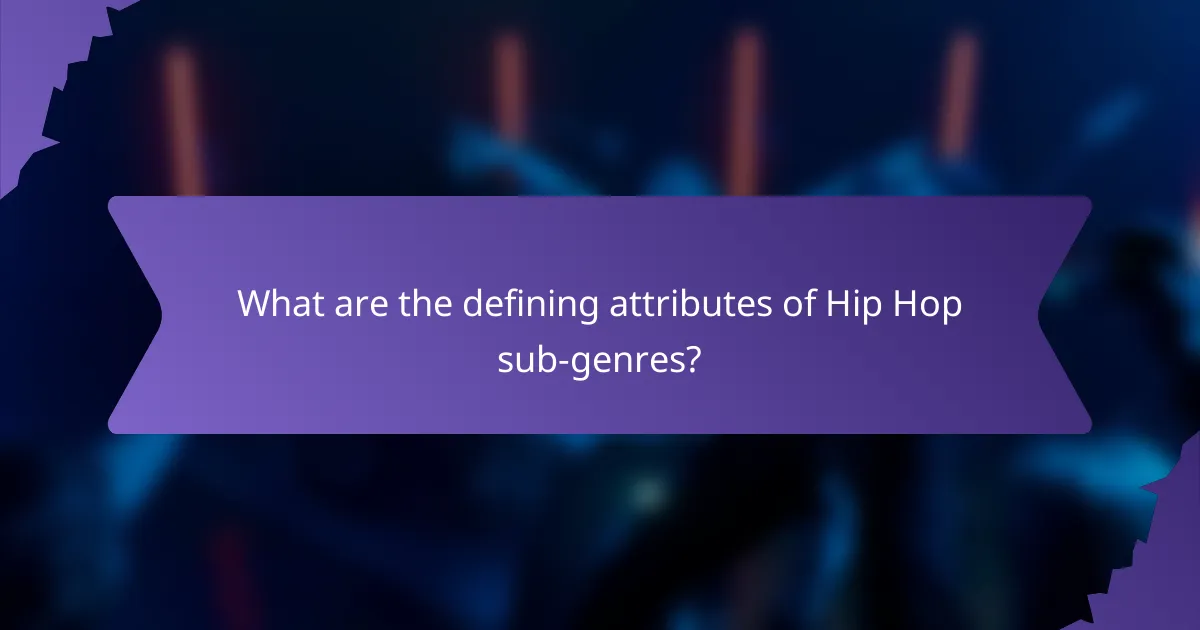
What are the defining attributes of Hip Hop sub-genres?
Hip Hop sub-genres are defined by their distinct styles, themes, and cultural influences. Key attributes include lyrical content, production techniques, and regional origins.
For example, East Coast Hip Hop often emphasises intricate lyrics and storytelling, while West Coast Hip Hop is known for its laid-back beats and party themes. Southern Hip Hop incorporates unique rhythms and influences from local music genres.
Additionally, sub-genres like Trap and Conscious Rap focus on specific themes such as street life and social issues, respectively. These defining attributes contribute to the rich diversity within the Hip Hop genre.
Which elements characterize Trap music?
Trap music is characterised by its heavy use of 808 drum machines, hi-hats, and aggressive beats. It often features dark, moody melodies and lyrics that reflect themes of street life and personal struggles. The genre emerged in the early 2000s, primarily from Southern hip hop, and has since evolved, influencing mainstream music. Unique attributes include the incorporation of synthesizers and a focus on rhythm over melody, setting it apart from other hip hop subgenres.
How does Conscious Rap differ from mainstream Hip Hop?
Conscious rap emphasises social issues and personal growth, contrasting with mainstream hip hop’s focus on commercial success and entertainment. Conscious rap often addresses topics like inequality, racism, and mental health, while mainstream hip hop typically prioritises themes of wealth, fame, and lifestyle. This distinction highlights the unique attribute of conscious rap as a vehicle for social commentary and activism, aiming to inspire change rather than simply entertain.
What makes Alternative Hip Hop stand out?
Alternative Hip Hop stands out due to its innovative fusion of diverse musical influences and strong social commentary. This genre often incorporates elements from jazz, funk, and electronic music, creating a distinctive sound. Its unique attribute lies in addressing social issues, personal experiences, and cultural narratives, setting it apart from mainstream hip hop. Additionally, Alternative Hip Hop artists often prioritise artistic expression over commercial success, further differentiating their work within the broader hip hop landscape.

Why is collaboration important in the Hip Hop community?
Collaboration is vital in the Hip Hop community as it fosters creativity and amplifies voices. Artists often unite to share experiences, blending diverse styles and perspectives. This synergy enhances social commentary, allowing for powerful messages on societal issues. Collaborations can also lead to unique sounds, pushing genre boundaries and attracting wider audiences. Ultimately, teamwork strengthens community ties and promotes cultural exchange within Hip Hop.
How do features and guest appearances enhance Hip Hop tracks?
Features and guest appearances enhance Hip Hop tracks by adding diversity, depth, and collaborative energy. They introduce unique perspectives and styles, enriching the listening experience. Collaborations often bring together different fan bases, increasing reach and engagement. Guest artists can provide fresh lyrical content and varied vocal delivery, which can elevate the overall production quality. Additionally, notable features can enhance credibility and draw attention to a track, influencing its success in the industry.
Which notable collaborations have transformed the genre?
Notable collaborations like Run-D.M.C. and Aerosmith’s “Walk This Way” and Jay-Z’s partnership with Linkin Park on “Collision Course” have significantly transformed hip hop. These collaborations bridged genres, expanded audiences, and influenced the sound of hip hop by integrating rock elements. Additionally, the partnership between Kendrick Lamar and SZA on “All the Stars” showcased hip hop’s evolving narrative depth and emotional resonance, highlighting social issues. Such collaborations demonstrate hip hop’s versatility and its ability to engage with diverse musical styles and cultural conversations.

What role does technology play in the evolution of Hip Hop?
Technology significantly shapes Hip Hop’s evolution by enhancing production, distribution, and accessibility. Digital tools enable diverse sounds and styles, fostering creativity. Platforms like social media amplify voices, allowing artists to reach global audiences. The integration of technology also democratises music creation, enabling aspiring musicians to produce high-quality tracks from home. As a result, Hip Hop continuously evolves, reflecting cultural shifts and technological advancements.
How has social media impacted the way Hip Hop is consumed?
Social media has transformed Hip Hop consumption by enhancing accessibility and fostering community engagement. Platforms like Instagram and TikTok enable artists to share music directly, bypassing traditional gatekeepers. This democratisation allows diverse voices and styles to emerge, reflecting broader social commentary. Additionally, user-generated content amplifies fan interaction, creating viral trends that shape the genre’s evolution. As a result, Hip Hop now thrives in a dynamic, interactive landscape, driven by real-time feedback and collaboration.
What advancements in production have changed Hip Hop music-making?
Advancements in production have transformed Hip Hop music-making by introducing digital tools and techniques. Software like Ableton Live and Pro Tools allows artists to create complex beats and manipulate sounds effortlessly. The rise of sampling technology has expanded the sonic palette, enabling innovative soundscapes. Additionally, access to affordable recording equipment has democratised music production, allowing diverse voices to emerge. These changes enhance creativity and accessibility, shaping the genre’s evolution.
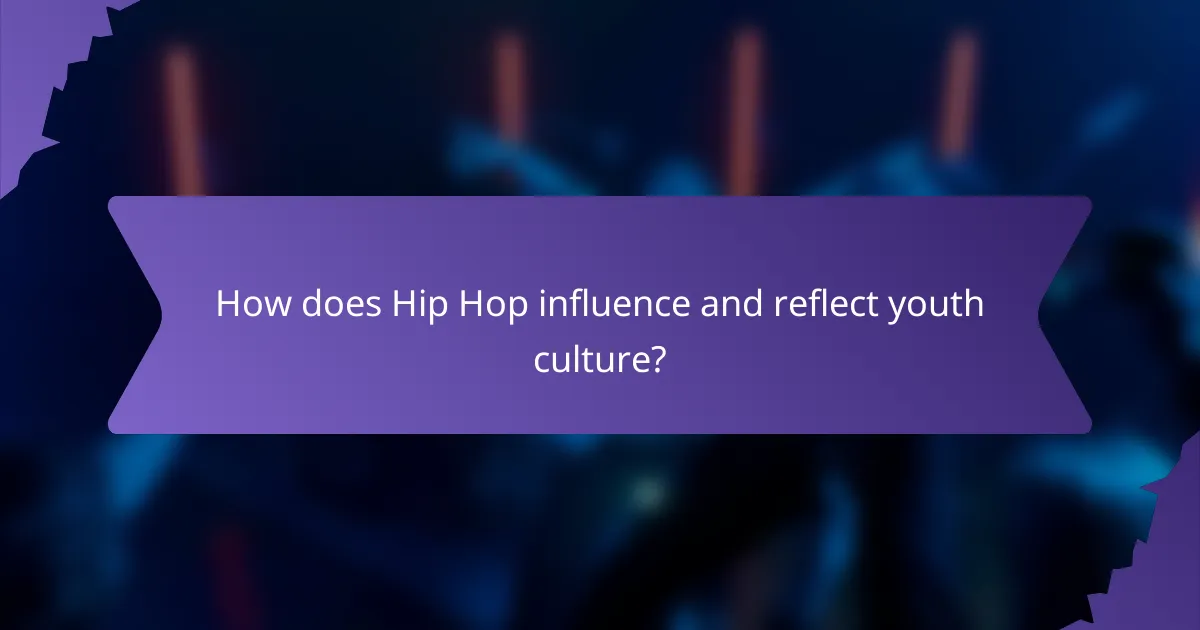
How does Hip Hop influence and reflect youth culture?
Hip Hop significantly influences and reflects youth culture through its themes, styles, and social commentary. It serves as a voice for marginalised communities, addressing issues such as inequality, identity, and resistance.
The genre’s roots in African American culture and its evolution into various sub-genres demonstrate its adaptability and relevance. For instance, trap music highlights contemporary struggles faced by youth, while conscious rap focuses on social justice.
Hip Hop also shapes fashion, language, and lifestyle choices among young people. The culture promotes self-expression and creativity, encouraging youth to engage in artistic endeavors.
As a result, Hip Hop not only mirrors the experiences of youth but also actively shapes their cultural landscape, making it a powerful force in contemporary society.
What role does fashion play in Hip Hop identity?
Fashion plays a crucial role in Hip Hop identity by expressing cultural narratives and personal stories. It reflects the genre’s roots in African American communities and serves as a medium for social commentary. Through clothing styles, artists convey messages about their backgrounds, aspirations, and societal issues. Unique attributes like streetwear and luxury brand collaborations highlight the genre’s evolution and influence. Fashion in Hip Hop fosters a sense of belonging and authenticity within the community, reinforcing identity and cultural pride.
How do dance styles associated with Hip Hop contribute to its culture?
Dance styles associated with Hip Hop significantly shape its culture by promoting self-expression, community, and social commentary. These styles, such as breaking, locking, and popping, reflect the experiences and struggles of marginalised communities. They serve as a powerful medium for storytelling and convey messages about identity, resistance, and empowerment.
The improvisational nature of Hip Hop dance fosters creativity and individuality, allowing dancers to showcase their unique perspectives. This encourages a sense of belonging within the Hip Hop community, where collaboration and competition coexist. Additionally, dance battles and performances often address social issues, making the art form a vehicle for cultural dialogue and awareness.
Moreover, Hip Hop dance styles have transcended geographic boundaries, influencing global dance trends while maintaining their roots. This cultural exchange enriches the Hip Hop narrative, reinforcing its role as a dynamic and evolving art form that continues to inspire and unite diverse audiences.
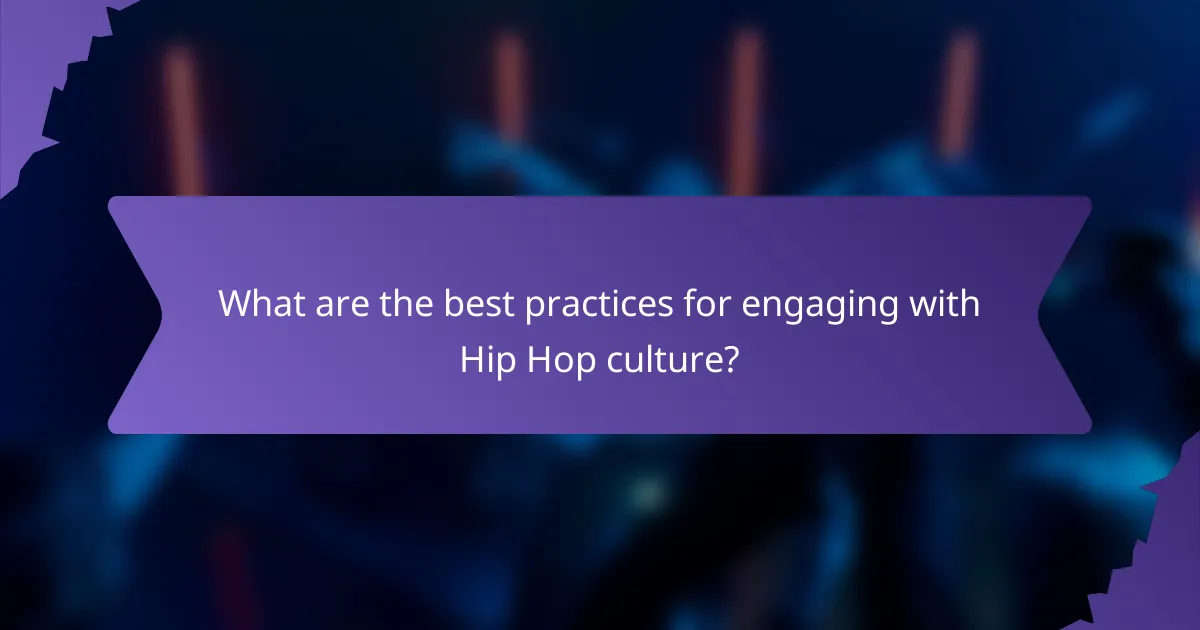
What are the best practices for engaging with Hip Hop culture?
Engaging with Hip Hop culture involves understanding its roots, appreciating its social commentary, and exploring its genre variations. To effectively connect with this vibrant culture, consider the following best practices:
1. **Educate Yourself**: Learn about the history and evolution of Hip Hop, including key figures and movements.
2. **Attend Events**: Participate in live performances, battles, and community gatherings to experience the culture firsthand.
3. **Support Artists**: Purchase music and merchandise from Hip Hop artists to contribute to their success and sustainability.
4. **Engage Online**: Follow Hip Hop discussions on social media platforms to stay updated and connect with fellow enthusiasts.
5. **Respect Diversity**: Recognise the various styles and subgenres within Hip Hop, including regional differences and influences.
6. **Promote Positive Messages**: Share and uplift content that reflects the positive aspects of Hip Hop culture, such as empowerment and unity.
How can one appreciate the depth of Hip Hop lyrics?
To appreciate the depth of Hip Hop lyrics, one must analyse their historical context, social commentary, and artistic techniques. Hip Hop serves as a reflection of societal issues, often addressing themes like inequality and resilience. Understanding the roots of the genre enhances appreciation for its complexities. Analysing metaphors, wordplay, and storytelling techniques reveals the artistry behind the lyrics. Engaging with diverse artists and their unique perspectives further enriches the experience.
What should new listeners know to navigate the Hip Hop landscape?
New listeners should understand Hip Hop’s diverse roots, its role in social commentary, and the various genre variations. Hip Hop originated in the 1970s in the Bronx, blending music, dance, and art to express cultural narratives. It serves as a powerful platform for addressing social issues, reflecting the struggles and triumphs of marginalised communities. Key genre variations include East Coast, West Coast, Southern, and alternative Hip Hop, each with unique characteristics and influences. Engaging with these aspects allows new listeners to appreciate the depth and richness of the Hip Hop landscape.